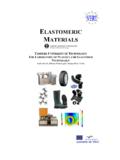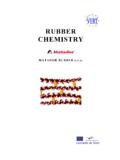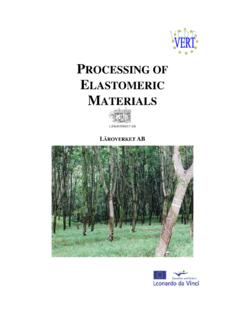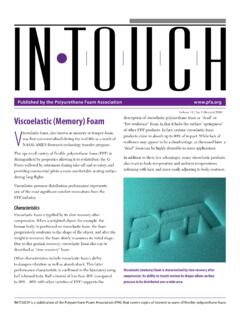Transcription of RUBBER CHEMISTRY - Läroverket i Småland AB
1 RUBBER CHEMISTRY MATADOR RUBBER Summary Rubbers - elastomers - are polymeric materials characterised by their ability of reversible deformation due to external deforming forces. Their deformation rate depends on the structure and molar mass of the deformed RUBBER and on external conditions of the deformation. This characteristics, referred to as elastic and/or hyper elastic deformation, is entropic in nature and results from the ability of RUBBER macromolecules to form a more organised state under influence of deforming forces without deformation of chemical bonds between atoms of the polymer chain or without deformation of their valence angles.
2 Ideally, the macromolecules can restore their initial position once the deforming forces are removed. Rubbers usually have long and regular macromolecule chains without bulk substitutes with spatially oriented structural units. This is the reason why their segments are movable and able to rotate around simple chemical bonds even at low temperatures, as it can be seen in their low vitrification temperature Tg. They are tough and similar to plastomers below the vitrification temperature or crystallisation temperature (if RUBBER can be crystallised).
3 When heated, rubbers change their elastic and/or hyper elastic state to a visco-elastic state; and they become plastic and flow above the softening temperature (Tm). It is advantageous if rubbers crystallise at normal temperature only when subjected to voltage and their Tg is significantly lower that the temperature they are used at. Natural RUBBER comes from a plant. In industrial applications , it is obtained primarily from Hevea Brasiliensis tree grown in orchards in South-East Asia, Western Africa and northern parts of Southern America.
4 Synthetic rubbers are made by constructional polyreactions of chain or grade nature. In terms of their application and basic properties they can be divided into: general - they have properties satisfying requirements of multiple products, often with various properties; they are relatively cheap; manufactured and consumed in large volumes (butadiene-styrene, butadiene, synthetic isoprene rubbers, natural RUBBER ); special - in addition to the basic elastic properties they have at least one special feature, such as resistance to aging, resistance to chemicals, resistance to budding in non-polar oils, resistance to high/low temperatures etc.
5 They are usually manufactured and consumed in lower volumes than general rubbers and they are much more expensive (ethylene propylene, chloroprene, acrylic, silicone, urethane, epoxy, fluorine rubbers and others). Rubbers are used most often in the form of vulcanizates - a vulcanized RUBBER . They can be brought to this form by vulcanization. This process is based on creation of chemical and physical transverse bonds between RUBBER macromolecules resulting in a spatial vulcanizate mesh, giving unique properties to the material.
6 Various chemical - vulcanizing - agents are used to create the chemical transverse bonds between RUBBER macromolecules (such as sulphur, peroxides, metal oxides, resins, quinones and others), which can react with appropriate functional RUBBER groups in the process of vulcanization to create transverse bonds between them. The cross-linking can be induced also by radiation, however its energy must be sufficient to Matador RUBBER 2007 2generate reactive forms of RUBBER macromolecules - radicals in most cases.
7 They react with each other giving rise to transverse bonds. Cross-linking can occur also due to microwave energy or ultrasound. Most rubbers require vulcanisation; though it is not inevitable for some type of thermoplastic rubbers. Anyway, the optimum vulcanizate ( RUBBER ) properties cannot be achieved only by cross-linking RUBBER molecules, but other additives must be added. Besides cross-linking agents and antidegradants (used to slow down the process of aging), they include fillers that have a positive influence on some of the utilisation properties and make them cheaper, as well as additives allowing admixture of all the powdery or liquid additives, often referred to as supplementary processing additives.
8 Rubbers, just like any other chemical compounds, can participate in other chemical reactions (polymer-analogical reactions) under suitable conditions because they have reactive function groups in their macromolecules (double bonds, reactive -hydrogen, other function groups). These usually include modification of undesired properties of rubbers ( resistance to aging, polarity, adhesion to other materials, linkage of antidegradants), or production of rubbers with some new properties (CIIR.)
9 BIIR, carboxyl rubbers). Intermediary reactions (cyclisation, isomerisation, degradation, cross-linking and others) can occur simultaneously with the main chemical reaction. Matador RUBBER 2007 3 Table of contents TABLE OF RUBBERS GENERAL BACKGROUND OF SYNTHESIS, STRUCTURE AND 1. 2. NATURAL NR 3 SYNTHETIC SOME FUNDAMENTAL OF SYNTHETIC RUBBERS BUTADIENE STYRENE-BUTADIENE ACRYLONITRILE-BUTADIENE ISOPRENE ISOPRENE-ISOBUTYLENE CHLOROPRENE ETHYLENE-PROPYLENE ACRYLIC FLUOROCARBON SILICONE POLYURETHANE POLYSULFIDE THERMOPLASTIC SOME ASPECTS OF RUBBER CHEMICAL 1.
10 POLYMER-ANALOGICAL CIS-TRANS 2. SOME POLYMER-ANALOGICAL REACTION OF CONVENTIONAL UNSATURATED HYDROGENATION, HALOGENATION, RUBBER modification Furan Driving Hevea 3. VULCANIZATION OF Vulcanization Crosslink Vulcanizates Matador RUBBER 2007 SULFUR Organic Sulfur Formation of Sulfur Thiuram Sulfur Conventional sulfur EV PEROXIDE Organic EPDM Thermosetic IIR Matador RUBBER 2007 5 RUBBERS GENERAL BACKGROUND OF SYNTHESIS, STRUCTURE AND PROPERTIES 1.






